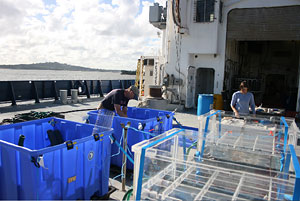

 | |||||||||||
|
|
Journals 2008/2009Jeff Lawrence
December 4, 2008 The science crew is busy today preparing the ship for travel off the Patagonian Shelf. The ship will be transecting down the coast of Argentina eventually arriving in Punta Arenas, Chile on January 2, 2009. The ship will sail through waters that can be very unsettled at times. Two major ocean currents meet off coast of Argentina causing high seas at times. There is a lot of expensive equipment aboard the R/V ROGER REVELLE and the last thing anyone wants to happens is for any of the equipment to be damaged or anyone on the ship to be hurt due to the moving lab equipment. Work must go on even in rough seas, equipment must be up and running giving the scientists the data needed to complete the expedition. The ship is very busy getting all the supplies loaded. Much of the scientific equipment was loaded in Tampa, Florida at the end of October, but other things are loaded that are needed such as food, general ship store supplies, and of course people. Scientist, graduate students, lab assistants, and others have been arriving over the past two days, settling into their cabins and learning their way around the ship. Each person has multiple tasks to complete to ensure that the studies objectives are met. The ship will run 24 hours a day with each crew doing a shift of 12 hours.
All hands on board whether it is the ship's regular crew or members of the scientific party have to work together to ensure everything is ready for the voyage. The ship will leave port later today and begin sailing to the first station where the data collection process will begin. Today I helped to secure several lab tables, CO2 canisters, and a Dewar, which holds liquid nitrogen. The Dewar is used to preserve some of the samples collected on the trip so that further studies can be done back in the labs after the expedition has ended.
Questions of the Day:
|
||||||||||

